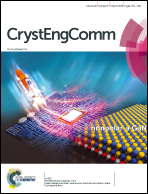Defect-related anisotropic surface micro-structures of nonpolar a-plane GaN epitaxial films
Abstract
The anisotropic surface etching behavior of nonpolar a-plane GaN (11![[2 with combining macron]](https://www.rsc.org/images/entities/char_0032_0304.gif) 0) epitaxial films, grown by pulsed laser deposition, was investigated experimentally by wet chemical etching. Crystal-orientation dependent face state, induced by anisotropic growth kinetics, is the origination of the anisotropic properties of the a-plane GaN epitaxial films. Defects that propagate into the surface offer initial positions for the etching process. A joint effect of two factors determines the etching-exposed surface morphology, primarily including triangular prisms and pits, thus making wet chemical etching a promising tool for the investigation of defect distribution. Type I1 basal stacking faults and partial dislocations are proven to have a direct connection with etching-exposed triangular prisms and pits, respectively. This study presents a mechanism research from the standpoint of the evolution process of the surface morphology during the etching process and brings insight for further understanding of the anisotropic properties of the nonpolar GaN epitaxial films for the realization of a high polarization light-emission device, which has a broad application in display and backlighting.
0) epitaxial films, grown by pulsed laser deposition, was investigated experimentally by wet chemical etching. Crystal-orientation dependent face state, induced by anisotropic growth kinetics, is the origination of the anisotropic properties of the a-plane GaN epitaxial films. Defects that propagate into the surface offer initial positions for the etching process. A joint effect of two factors determines the etching-exposed surface morphology, primarily including triangular prisms and pits, thus making wet chemical etching a promising tool for the investigation of defect distribution. Type I1 basal stacking faults and partial dislocations are proven to have a direct connection with etching-exposed triangular prisms and pits, respectively. This study presents a mechanism research from the standpoint of the evolution process of the surface morphology during the etching process and brings insight for further understanding of the anisotropic properties of the nonpolar GaN epitaxial films for the realization of a high polarization light-emission device, which has a broad application in display and backlighting.



 Please wait while we load your content...
Please wait while we load your content...